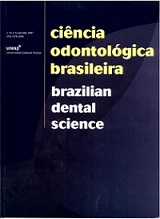Nifedipine-Induced gingival overgrowth
DOI:
https://doi.org/10.14295/bds.2012.v15i4.836Abstract
Objective: The objective of the present study was to evaluate gingival overgrowth induced by nifedipine and to correlate it with plaque accumulation. Material and Methods: Sixty patients were divided into a treated group (n=30) consisting of hypertensive patients treated with nifedipine and a control group (n=30) consisting of patients without arterial hypertension. The following exams were performed on the first visit: anamnesis, measurement of blood pressure, weight and height, extra- and intraoral examination, and determination of the vertical and horizontal gingival overgrowth indices, plaque index, and bleeding index. The measurements were repeated after 30 days. Results: Most patients using nifedipine (60.7%) presented grade I horizontal gingival overgrowth (1 to 2 mm), with 3.6% showing minimum vertical gingival overgrowth. On the return visit, the plaque index was reduced by 8.3% and bleeding on probing was reduced by 1.5%. A significant difference in the horizontal gingival overgrowth index was observed between the treated and control groups (chi-square test, p = 0.015, p < 0.05). Conclusions: The present results demonstrated moderate gingival overgrowth induced by nifedipine and a correlation with oral hygiene.
Key words: gingival overgrowth, nifedipine, periodontal diseases.
Downloads
Downloads
Published
How to Cite
Issue
Section
License
Brazilian Dental Science uses the Creative Commons (CC-BY 4.0) license, thus preserving the integrity of articles in an open access environment. The journal allows the author to retain publishing rights without restrictions.
=================




























